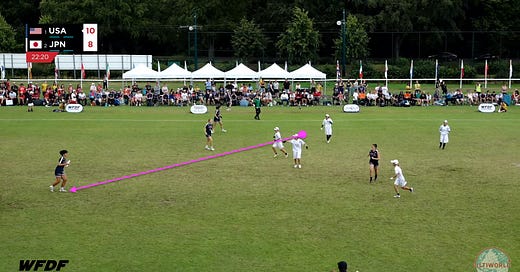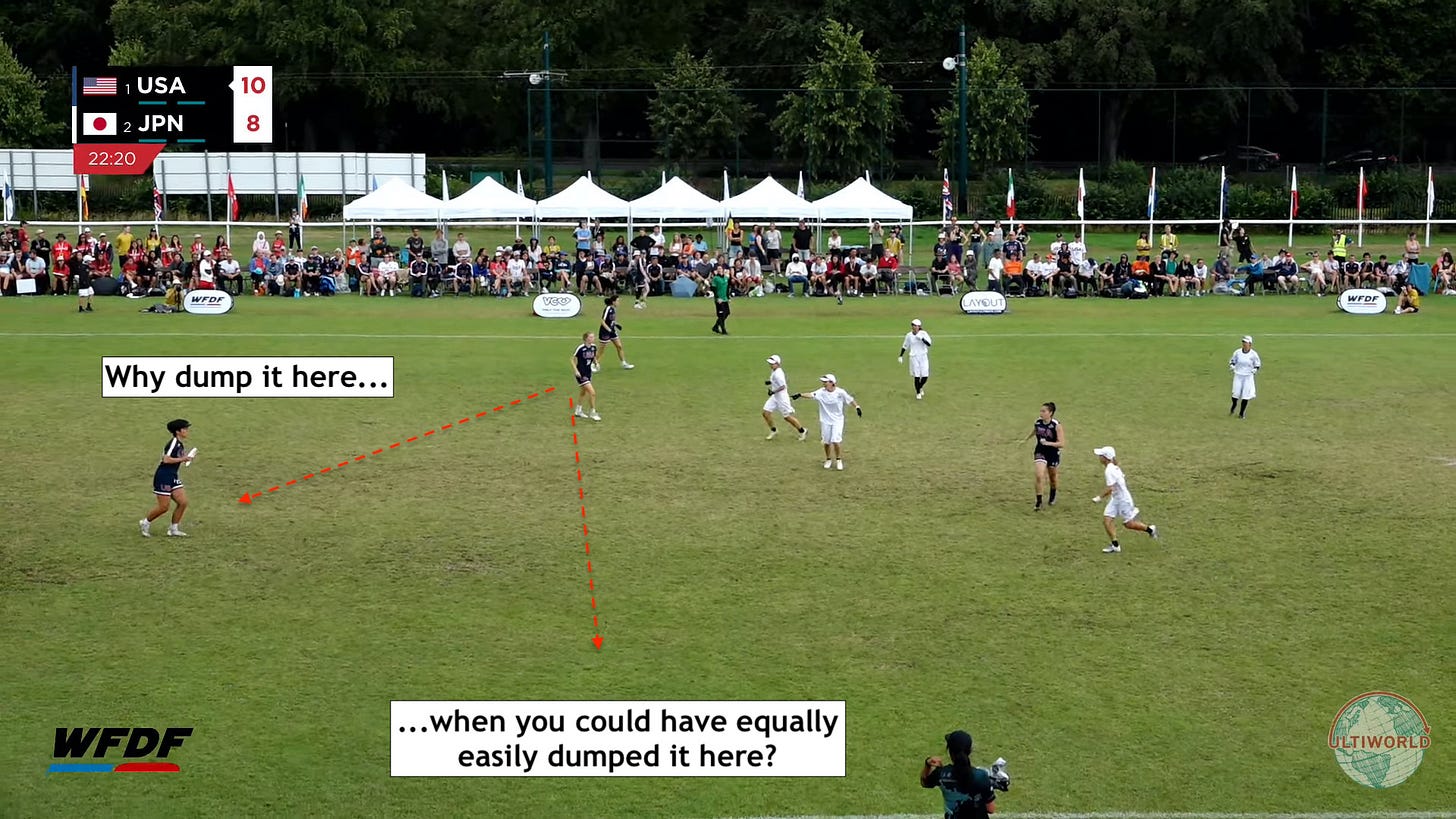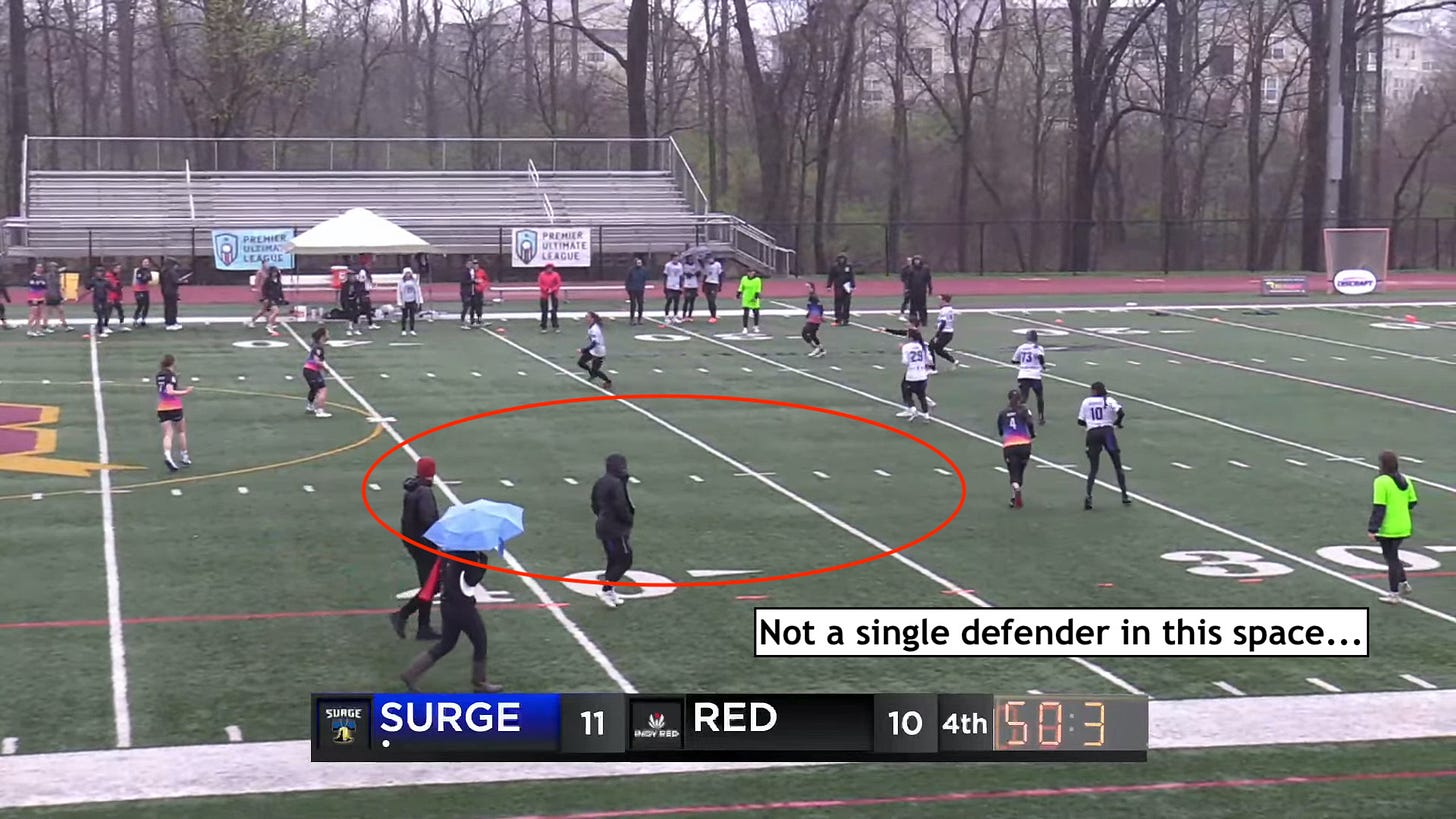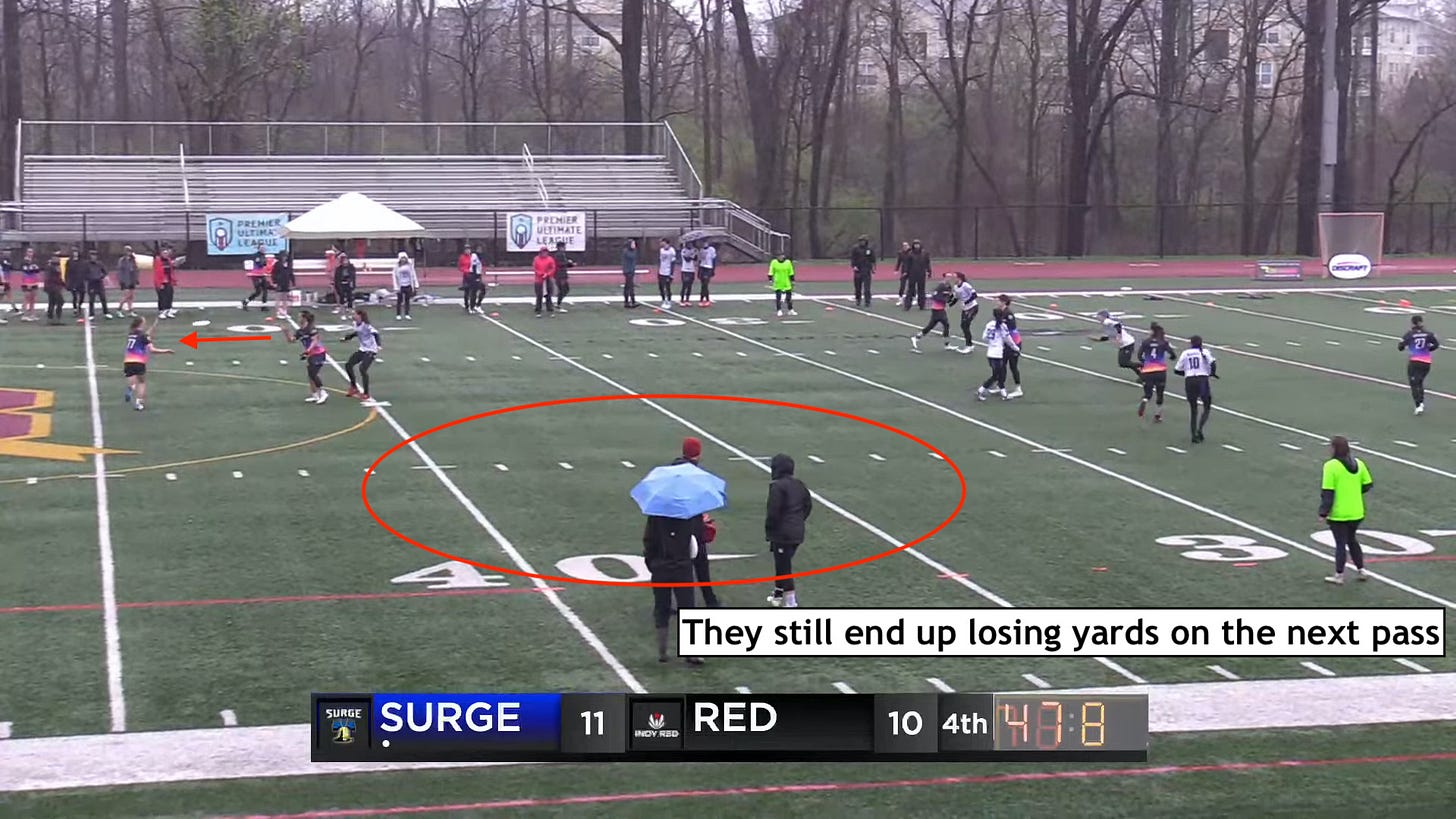Don't lose more yards than necessary on dump throws
Backwards passes are important but let's do them thoughtfully
Do yards matter in ultimate frisbee? In other words, all things being equal, is it better to be closer to the endzone where you're trying to score? Intuitively, the answer is obviously, yes—having the disc closer to the goal you're attacking makes it easier to score. Some of the existing data on this is not as clear as I'd have expected, but to focus on the topic at hand I've moved that discussion to the Appendix at the bottom. For now, let's just take it for granted that field position does matter.
It's not my first time writing about paying attention to gaining yards—one of my earliest posts about ultimate frisbee was Take the free yards. Let's return to that theme to highlight one particular situation where we often see players being too nonchalant—dump passes.
Throwing backwards is good, but...
Throwing the disc backwards is a very important part of frisbee. Too many people, at all levels of frisbee, are too reluctant to throw the disc backwards. Backwards passes have lots of benefits:
Sometimes it's the only way to ensure we keep possession
The angle change can open up new options (I don't have a good angle to get a pass to the other side of the field, but a person behind me does)
Every time the disc changes location, defenders have to expend effort to re-optimize their positioning
A backwards pass to a player facing forward can get the disc to a player who has a better sense of the current downfield options.
etc, etc
There are many good reasons to move the disc backwards—but that doesn't mean that we can thoughtlessly apply the "pass backwards good" heuristic. Not all backwards passes are equal.
Specifically, given the importance of yards, we shouldn't lose more yards than necessary to achieve our goals. If a 5-yard backwards pass would give the new thrower enough space to swing the disc across the field, we shouldn't be just as happy with a 10-yard pass backwards.
An example of lost yards
Let's look at an example from the 2023 U24 World Championships. Watch the sequence below, starting with a deep huck to Stacy Gaskill. Two of the next three passes after the huck are, in my mind, "bad" dump passes.
Notice the pass from Gaskill to Birdsong, and then, after Birdsong dishes it to Flores, the pass from Flores to Chang. Why do I think these are bad dump passes? Because there are quite clearly ways to achieve the same goals without losing as many yards. The yardage lost isn't enabling further swing passes, or giving the disc to a teammate with a much better perspective, or ensuring the possession continues in the face of a high stall count. Anything gained by the disc movement could have been gained equally well without losing so many yards.
In both cases, there were clear opportunities to move the disc to the same player without sacrificing field position. When Gaskill dumps to Birdsong, there was lots of open space in front of Birdsong's position, on either side of Gaskill:
When Flores throws backwards to Chang, there's nothing but green grass in front of Chang for ten yards or so.
These two passes add up to a pretty big yardage loss with no defensive pressure:
And again, the yardage loss doesn't help the US team generate an initiative—Chang ends up holding the disc until the Japanese defense is set.
What to do instead
Both the thrower and the receiver can help ensure there's no unnecessary yardage loss in situations like these.
As a thrower, I do two things in this situation:
Use my hands and my voice to signal to my receiver that I want them to keep moving forward.
[Update (2024-09-17)]: You can see Austin Torch’s Clara Stewart encourage a teammate to come forward for extra yards in the clip below (She’s #73, who catches the first pass when the clip starts. After pointing and faking downfield, she waves/beckons her hand at the side handler):Throw a pass that's in front of the receiver (a "leading pass"), to force them to come forward into the open space
Here's Manu Cardenas throwing a leading pass in the 2023 Pro Championships tournament:
No one is guarding the target of her dump pass, so she leads the receiver forwards onto the disc. They ultimately end up 3 yards closer to the endzone than they might have been if Manu had thrown the pass to the receiver's back shoulder. Three yards isn't much, but it adds up over the course of a game and a season!
The receiver also has an important role to play in these situations. When I'm in these situations as a receiver, I use a matching set of techniques to get the job done:
I move forward into the open space as far as I safely can while still being open
I use my voice and hand signals to tell the thrower I want them to throw it in front of me
When possible, I catch the pass with forward momentum to gain a few extra yards in the process of slowing down.
The last point is a relatively well-known technique. For example, in the following Hive Ultimate clip, Felix shows how Manu Cardenas (her again!) turns a tiny sideways pass into a five-yard gain.
Sometimes, catching with forward momentum isn't possible once the pass is in the air, like on the pass from Flores to Chang. In that case, I'd use the other two options if I was in Chang's shoes—moving forwards earlier, and using communication before the throw to ask for a pass in front of me.
In other situations, it is possible. Given the angle of the pass, Birdsong could have accelerated forwards towards the incoming pass, as Manu does, instead of standing still waiting for it to arrive. Gaining yards with forward momentum is something of an add-on, though. Communication and positioning before the throw are the priorities.
When I'm receiving similar dump passes, while I do move forward into the open space (as per my first bullet point), I often don't move as far forward as I possibly could. I like to stay back just far enough that I can still encourage the thrower to lead me forward into the space.
I've noticed a few benefits to doing this:
First, I catch the disc with extra forward momentum, as Manu does in the clip above.
Second, because I'm starting a bit further from any defenders, I'm "more open" and there's higher certainty that the thrower will feel comfortable passing to me.
Third, I can catch the disc facing downfield, so it's easier to find a target for my next pass.
Catching the disc facing downfield is an example of a more general concept called "facing the space"—in other words, using your footwork and positioning to keep the maximum amount of the field in your line of sight. As a receiver of these dump passes, you're generally facing the space—you have the entire field in front of you, so it's easier to figure out exactly how far forward you can move.
Final thoughts
In summary:
As a thrower: use your hands and your voice to tell your receiver they should keep coming forward. Lead them forward with the throw to help them gain even more yards.
As a receiver: use your hands and your voice to tell your thrower to lead you forward. Simply move up the field as far as you can while still being open. Catch the disc with forward momentum to gain extra yards and have a better view of your potential next targets.
And let me say one more time—throwing backwards passes is important. Please don't use this article as evidence you should throw backwards less. But whatever we do on the field, we should do it efficiently and with our ultimate goal in mind—and that includes backwards passes.
Better field position makes everything just a little bit easier. In the Team USA example above, the possession ends a few passes later with a short huck that is inches from being caught. But if the team hadn't lost 10+ unnecessary yards, that incomplete throw would've been significantly shorter and (on average) more accurate. Attention to detail pays off over the course of a game, tournament, and season.
Appendix: do yards matter?
I think field position obviously matters, but the hard data we do have is admittedly inconclusive. This old Ultiworld article tracked game data to determine the probability a point would end in a goal given the disc was at a certain location on the field.
The NexGen team's heat map just about matched what I'd expect to see. Closer to the attacking goal (i.e. the right edge of the image), they're more likely to score:
However, the combined heat map of their opponents doesn't have such a clear pattern. There's a spike right near the attacking goal, especially in the corners, but other than that there isn't a clear gradient. (Or maybe I'm about to find out I'm colorblind! Let me know if you disagree with my interpretation.)
The text of the article agrees with my intuition that field position obviously matters, saying:
the data is consistent with the simplest theory of Ultimate offense, where possession further away from the endzone generally requires completing either more passes or longer ones.
But again, while the NexGen graph agrees with that, I'm not sure their opponents' scoring chart does.
Given the somewhat inconclusive data, I'm going to stick with my intuition that yards obviously matter. We'd also expect yards matter the least in games where offenses can most easily gain yards without turnovers. In other words, with exactly the super-elite men's division teams examined in Ultiworld's article. If your team turns the disc over more than NexGen did, yards should matter all that much more to you.
[Update 2025-04-24]: Here’s another example from a 2025 PUL game. Note that it was the last point, with under a minute left, and they needed to score. If ever there’s a time you should be laser-focused on moving forwards, it’s then (but really, you should always be laser-focused on moving forwards!).









